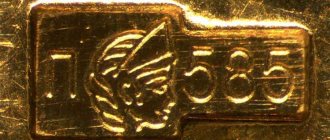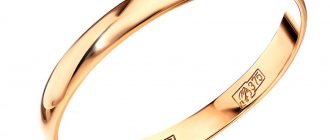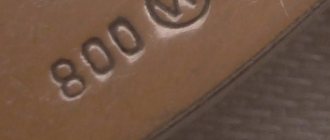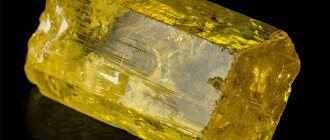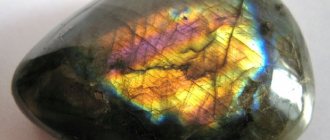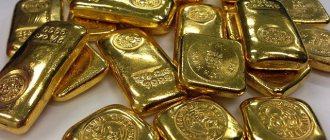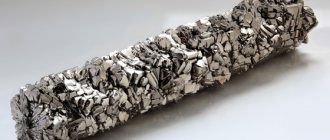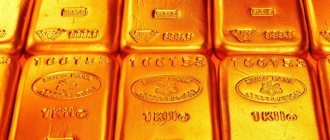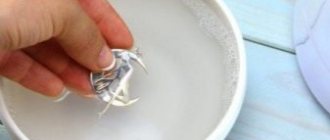What's included
Since not all women and girls can afford to wear items made of gold, silver or platinum, jewelers use costume jewelry to make more affordable jewelry. What it is? The photos presented in the article demonstrate the varied beauty made from this material. These can be beads, earrings, clips, rings, bracelets, hair decorations (hairpins, headbands, crabs), brooches, etc.
When making an alloy, tin is most often used as a base. In its natural form, it is not suitable for the production of forged products, since it is refractory and brittle. Therefore, since ancient times, other metals have been added to tin. What else can be included in the alloy? This includes aluminum, copper, antimony, and any other metal that has hypoallergenic qualities and does not irritate human skin. When copper is added, the alloy becomes ductile, and antimony maintains the bright and sparkling appearance of the product for a long time.
Sometimes manufacturers use zinc as a basis in order to reduce the cost of jewelry. However, the appearance will be strikingly different from pewter.
Description of jewelry alloys
Of the eight precious metals, jewelers use only three in their work - platinum, silver, and gold. In their pure form, precious metals are soft and quickly tarnish, so they are not suitable for the production of jewelry. In the manufacture of products, alloys are used - materials consisting of noble and non-ferrous metals.
Impurities improve the operational and decorative characteristics of the decoration, increase strength and reliability. Additives that are added to the base to change the properties are called ligature (Latin Ligature - “connection”). List of allowed alloying components: Cu, Ag, Pt, Co, Ni, Cd, Zn, Pd.
The composition of the jewelry ligature must comply with state standards. The proportion of components is regulated by the state (GOST 30649-99). The products are marked with an assay mark, which reflects the quantitative ratio of the components.
Precious jewelry must be hallmarked if the proportion of precious metals in the raw material exceeds 30%
In the modern world there are two sampling systems. One is metric, in which the hallmark indicates how much precious metal in milligrams is contained in 1 g of raw material. In another (carat) system of samples, they operate with a conventional unit. 1 carat is taken to be 4.1 g of pure precious metal per 100 g of raw material.
Forbidden additives
It is noteworthy that already in the 19th century, jewelry alloy was widely used, the composition of which also included lead until the end of the century. But when scientists discovered that it remained on the skin, this additive was strictly banned. Today, the absence of lead in such alloys is prescribed at the legislative level.
Another forbidden metal that should never be in a good jewelry alloy is nickel. The reason for this is the negative effect of metal on the skin, which can result in an allergic reaction.
Dual alloy systems
Gold is an alloying component
GOLD - aluminum. Gold is practically insoluble in aluminum (see picture below).
Gold - beryllium
(see picture below).
Gold is vanadium.
The solubility of vanadium in gold at 970° C is approximately 17.5 at. % (5.2 wt.%) and at 500° C 14 at. % (4 wt.%) vanadium (see picture below).
Gold is bismuth.
The solubility of bismuth in gold is 0.02% at 1040, 0.04 at 1000° C, 0.07 at 900° C, 0.03 at 800 and 700° C and less than 0.03 at 600 and 500° C. At With a further decrease in temperature, solubility is practically absent.
Gold is hydrogen.
Gold does not combine with hydrogen to form hydrides. Hydrogen does not dissolve in either solid or liquid gold (up to 1300° C).
Gold is gallium.
The solubility of gallium in gold at 500° is 11.15 at. % (4.25 wt.%), at 455° C 12.5 at. % (4.8 wt.%), at 400° C 11.8 at. % (4.52 wt.%), at 350° C 10.9 at. % (4.15 wt. %) at 300° C 9.4 at. % (3.54 wt.%), at 270° C 8.1 at. % (3.05 wt%) (see picture below).
Gold - indium.
The solubility of indium in gold is 11.3 at. % (6.9 wt. %) at 767 ° C, 12.65 at. % (7.8 wt.%) at 700° C, 12.57 at. % (7.7 wt. %) at 650 r C, 11.7 at. % (7.1 wt.%) at 560° C, 10.96 at. % (6.7 wt.%) at 482° C and 10.36 at. % (6.3 wt.%) indium at 406 ° C (see the figure below).
Gold is iridium.
In the liquid state they have a solubility gap from 2 to 99.9 wt. % gold.
Gold - cadmium
(see picture below).
Gold is calcium.
The solubility of calcium in gold at 800°C is less than 1.8 at. % (0.3 wt.%) Ca and gold in calcium at 658° C, calculated as 4.5 at. % (19 wt.%) Au (see figure below).
Gold is oxygen.
In the liquid state, oxygen does not dissolve in gold.
Gold-cobalt.
They form a eutectic at a temperature of 996° C, containing 27 at. % (10 wt.%) cobalt. Hypoeutectic alloys have a very narrow crystallization range. The solubility of cobalt in gold at 996°C is 23.5 at. % (8.4 wt.%), at 800° C—8.1 at. % (2.6 wt.%), at 600° C 2.3 at. % (0.7 wt.%), at 400° C 0.2 at. % (0.1 wt.%) cobalt. In hypereutectic alloys, at 1122° C, a magnetic transformation of cobalt occurs. The solubility of gold in cobalt at 1200° C is 2.5 at. % (7.9 weight, %), at 996°C 1.9 at. % (6.1 wt.%), at 900° C 1.4 at. % (4.5 wt.%), at 700° C 0.5 at. % (1.6 wt.%), at 500° C 0.3 at. % (1.0 wt.%) gold. At ~ 420° C β-Co ↔ α-Co.
Gold-magnesium. The solubility of magnesium in gold is ~ 3.5 wt%, gold at 576 ° C; in magnesium 0.1 at. % (0.8 wt%) gold1 (see picture below).
Gold is manganese.
The solubility of manganese in gold at 960°C is 30.8 at. % (10.9 wt. %) MP.
Gold-copper.
Gold and copper in the liquid state are mutually soluble in any ratio (see the figure below). During crystallization, alloys of the Au - Cu system form a continuous series of solid solutions with a minimum point at 82 wt. % gold and 884° C [37] and at 80 wt. % (56 at.%) gold and 889° C [3].
The gold-copper solid solution has a face-centered cube lattice. The lattice constant varies additively with composition, with a slight positive deviation. While studying the Au-Cu system, N.S. Kurnakov and his co-workers first established the possibility of ordering a solid solution. As the temperature decreases, the solid solution of copper and gold formed after solidification undergoes transformations. On the curves of changes in the properties of alloys of the Au - Cz system in the solid state, maxima are found that correspond to the chemical compounds Cu3Au (50.85 wt.% Au) and CuAu (75.63 wt.% Au). The reason for these reactions is the tendency to order the arrangement of atoms with decreasing temperature.
The ordering process with the release of the Kurnakov CusAu phase occurs in the concentration range from 37.5 to 52.5% Cu. The region of formation of the Cu3Au phase is limited on the curve diagram with a maximum at a temperature, according to most studies, 388 ± 3°. The ordering of the arrangement of atoms and the transition to the Cu3Au phase occurs without changing the lattice type: the lattice of the cube with centered faces is preserved.
The ordering process with the formation of the CuAu compound occurs in the concentration range from 15 to 32.5% Cu. The area of formation is limited on the curve diagram with a maximum at a temperature, according to most studies, 415 ± 10 ° C. The ordering of the arrangement of atoms is accompanied by a change in the type and parameters of the lattice and is expressed in the x-ray diffraction pattern, in addition to the appearance of superstructural lines, by the splitting of part of the interference lines of the solid solution. It was determined that the ordered phase exists in two modifications: АuCuI and АuCuII. The AuCuI modification, established earlier, has a tetragonal lattice. The structure of AuCuII is orthorhombic and is closely related to the tetragonal structure of AuCuI.
It is noted that copper and gold atoms change their position in the lattice in the reverse order (so-called antiphase domains), and there are periodic defects at the boundaries of antiphase domains. We can assume that the AuCuII structure consists of 10 slightly distorted tetragonal cells located nearby. The transition from AuCuII to AuCuI occurs in a narrower concentration range. The curve limiting the boundaries of the transition from AuCuII to AuCuI has a maximum at a temperature of 385 ± 10 ° C. The AuCuII phase is detected during long-term tempering of alloys containing 36-47 and 53-65 at. % Au, at a temperature of 200-400° C.
At the boundary of the regions of existence of AuCuI and AuCuII, the existence of a two-phase region AuCuI + AuCuII is assumed. In the interval of the phase diagram between the precipitation fields of Cu3Au and CuAu, a eutectoid is formed at 36-37 at. % Au and 285-300° C. In the concentration range 65-80% at. % as a result of a peritectic reaction, the chemical compound CuA3 is formed at 230-250° C. There is apparently no maximum on the curve limiting the region of transition from the (Au, Cu) solid solution to the CuAu3 phase. The CuAu3 phase has not been studied in detail. The solid solution region is separated from the regions of existence of Kurnakov phases by double lines, which indicates temperature hysteresis of transformations. The technology of gold alloys containing copper (double, ternary and multicomponent) is significantly influenced by ordering in certain concentration ranges. Outside these intervals, the Au - Cu and Au - Ag - Cu alloys are ductile in the hot and cold states. Alloys in which ordering of the solid solution occurs (Au - Cu, Au - Ag - Cu) must be cast with a high cooling rate (crystallization). If ordering significantly worsens technological characteristics (for example, in the AuCu region), hardening is carried out in order to increase ductility and reduce deformation resistance.
When heat treating Au - Cu and Au - Ag - Cu alloys, a neutral or slightly reducing atmosphere is desirable (a mixture of carbon monoxide and carbon dioxide, dissociated and incompletely burned ammonia, nitrogen, inert gases, vacuum).
Gold is molybdenum.
F ↔ (Au) + (Mo) at 1054°C. Solubility in gold 1.25 at. % .(0.61 wt.%) at 1054°C, 1.2 at. % (0.59 wt.%) at 1000°C; 1.05–1.1 at. % (0.52–0.54 wt.%) at 800° C, 0.9–0.95 at. % (0.044-0.46 wt.%) at 600° C, 0.9 at. % (0.44 wt. %) at 400° C and 0.7 at. % (0.34 wt.%) molybdenum at 200° C. Gold is practically insoluble in molybdenum.
Gold is sodium.
F ↔ NaAu2 + Au at 17.0 at. % (2.3 wt.%) sodium and 876° N. F ↔ Na2A+ Na at 96.7 at. % (77.5 wt.%) sodium and 82°C Sodium in gold is practically insoluble.
Gold-nickel (see picture below).
Au - Ni system: a - state diagram; b - Brinell hardness; 1 - magnetic transformation; 2 - hardened at 900° C; 3 - annealed
Gold-tin.
The solubility of tin in gold at 498° C is 6.8 wt. % (4.2 at. %); At 450° C 6.3 wt. % (3.9 at.%), at 400°C 5.9 wt. % (3.6 at. °/about), at 350 ° C 5.6 wt. % (3.5 at.%) Sn, and gold in tin at 200°C 0.2 wt. % (0.3 at.%).
Gold is osmium.
Osmium is practically insoluble in gold.
Gold-palladium.
They form a continuous series of solid solutions.
Gold—praseodymium.
The solubility of praseodymium in gold is 0.4 wt. % (0.55 at. %) (see the figure below).
Gold is mercury.
The solubility of mercury in gold is 17.3-19.3 at. % (17.5-19.6 wt.%) at 400° C, 16.1-17.9 at. % (16.3-18.2 wt. %) at 300 ° C, 15.6-16.8 at. % (15.8-17.0 wt. %) at 200 ° C and 15-17 at. % mercury at 100°C. (see picture below).
Electrical properties of platinum-gold alloys
| Properties | Alloy condition | Au content, at. % (weight. %) | ||||||||||||||
| ρ25 μΩ • cm | Annealed Hardened | 600°С 800°С 900°С 1000°С | 18,41 19,16 20,95 18,69 19,35 | 19,26 24,20 24,38 23,35 27,02 | 19,14 16,58 22,39 26,27 35,70 | 22,76 23,98 19,44 29,76 33,49 | 19,26 23,16 25,08 26,62 36,93 | 20,84 25,01 26,61 27,76 36,75 | 25,70 29,68 29,02 32,23 45,23 | 25,25 27,56 29,35 31,28 44,02 | 23,53 26,54 27,84 30,45 47,08 | 25,22 35,04 36,71 38,99 45,62 | 26,61 30,77 31,01 30,18 33,39 | 21,58 23,79 25,11 25,68 28,13 | 12,90 18,73 21,07 20,54 20,90 | |
| ρ100 μΩ • cm | Annealed Hardened | 600°С 800°С 900°С 1000°С | 21,29 22,14 24,19 21,71 22,56 | 22,17 26,95 27,29 26,00 29,91 | 21,89 18,46 24,87 29,05 38,38 | 25,41 26,41 21,19 32,35 35,58 | 21,34 25,34 27,31 28,80 39,08 | 23,05 27,12 28,80 29,63 37,46 | 26,68 31,99 29,33 36,48 47,56 | 26,84 29,02 30,72 32,42 44,78 | 24,88 27,46 28,88 31,79 48,04 | 26,48 36,17 37,72 40,13 46,29 | 27,55 31,48 31,94 31,04 34,31 | 22,41 24,42 26,00 26,12 28,95 | 13,63 19,57 22,12 21,54 21,92 | |
| α × 1010 | Annealed Hardened | 600°С 800°С 900°С 1000°С | 22,02 21,82 21,20 22,75 23,43 | 20,70 15,71 16,55 15,71 12,02 | 20,40 15,64 17,62 14,59 10,20 | 16,60 14,00 12,44 15,37 8,50 | 14,96 12,86 12,24 11,18 7,59 | 14,69 11,81 11,31 9,11 8,20 | 11,94 11,43 11,27 9,63 5,67 | 9,28 7,21 6,38 4,91 2,64 | 7,78 4,63 5,08 5,88 2,77 | 6,22 4,36 3,73 3,94 2,61 | 4,92 3,09 3,87 3,07 3,71 | 5,21 3,56 4,81 2,10 2,77 | 7,63 6,94 6,82 6,62 6,53 | |
Gold—ruthenium.
~ 1 wt. is dissolved in liquid gold. % Ru. At 1066° C, the transformation occurs L + β↔α and the solubility of ruthenium is ~ 1 wt. %, with decreasing temperature it decreases.
Gold is lead.
The solubility of gold in lead at 200°C is 0.08 wt. % (0.076 at.%) and at 170° C—0.03% gold.
Gold is antimony.
The solubility of antimony in gold at 600° C is 1.12 at. % (0.7 wt.%), at 500° C 1.1 at. % (0.68 wt.%), at 400° C 0.91 at. % (0.56 wt.%), at 300° C 0.34 at. % (0.21 wt.%) and at 200° C 0.0 at. % antimony.
Gold—thallium.
The solubility of thallium in gold is equal to (see the figure below): Temperature, °C 1040 1000 900 800 600 500 450 400 300 200 Solubility, at. % 0.48 0.75 0.79 0.90 0.82 0.71 0.51 0.35 0.21 0.17
Gold is tellurium.
Tellurium is practically insoluble in gold: about 0.01 wt. % tellurium (see figure below). The tellurium content in gold and alloys is permissible in an amount of no more than 0.01%, as it causes brittleness during cold and hot deformation.
Gold is titanium.
Solubility of gold in β-Ti three 1000 ° C 5.0 at. % (17.9 wt.%), in α-Ti at 830° C ~ 1.7 at. % (6.6 wt.%) and at 600° C 0.7 at. % (2.8 wt%) gold (see picture below).
Gold—thorium.
Thorium is practically insoluble in gold (see picture below).
Gold is carbon.
Molten gold, when significantly heated above the melting point, dissolves up to 0.3% carbon. Gold carbide Au2C2 is very unstable.
Gold-phosphorus.
Liquid silver absorbs phosphorus vapor. In the solid state, these components are mutually insoluble.
Gold - zirconium.
The solubility of zirconium in gold is 7.25 at. at 1065°C. % (8.5 wt.%), at 1000° C 7.1 at. % (3.4 wt.%), at 900° C 6.1 at. % (2.9 wt.%), at 800° C 4.4 at. % (2.1 wt.%), at 700° C 3.0 at. % (1.4 nes.%), at 600° C 1.75 at. % (0.8 wt.%) and at 500° C 0.75 at. % (0.85 wt.%) zirconium.
What does the appearance say?
Jewelry craftsmen can simply figure out by eye what the jewelry alloy is made of. If the color of the product is slightly dull and matte, then tin plays the “main violin” in the composition. This decoration will be light, but brittle. If there is a reddish tint, then the alloy contains copper. In this case, the color will change slightly, since the aged look was originally intended. A yellow-green (sometimes yellow-gray) shimmer indicates the presence of brass in the composition.
Some jewelry alloys contain steel, and jewelry made from it has a corresponding gray, metallic tint or made to look like silver based on chromium. If the alloy product is too dark in color, this indicates the addition of nickel, which causes allergies in sensitive people. Less common are titanium alloys, which give jewelry durability and strength, but are many times more expensive.
LiveInternetLiveInternet
Taken from here: https://www.livemaster.ru/topic/1132525-bizhuternyj...hego-sdelany-nashi-ukrasheniya
Good to know 
The most common material used in costume jewelry is electroplated jewelry alloy. Most rings, earrings for earrings, locks, etc. are made from it. colors “antique bronze”, “antique copper”, “antique silver”. To create such a variety of shades, electroplating is used: silver plating, gold plating, copper, bronze, brass, chrome, etc. I have come across several basic jewelry alloys:
Tin-based jewelry alloy , which may include copper, aluminum, antimony or any other hypoallergenic metal that does not oxidize upon prolonged contact with human skin. It is simply designated as Metal Alloy.
Zinc-based alloy - such products differ from tin, since the alloy itself is harder, less flexible and a little dull. It is designated Zink (Metal) Alloy.
3. An alloy based on brass, an alloy again of zinc and copper, with an admixture of other metals. Designated as Brass (an alloy based on copper and zinc or brass and copper).
4. Stainless steel. This material is non-poisonous, tough and high temperature resistant. The luster of stainless steel is close to platinum luster, and its surface does not change under the influence of environmental changes, maintaining its shine and gloss despite long periods of wear. In addition, stainless steel is easy to clean. There is no need for special cleaning unless stainless steel jewelry is used in a highly acidic environment. Often referred to as Platinum, Steel, Nickel.
5. Surgical steel (hypoallergenic). Contemporary jewelry offers jewelry made of surgical steel with gold, titanium and carbon coating in a strict classical, hi-tech, informal and even Gothic style. The shade is often designated as Platinum, Steel, Nickel.
These alloys are worthy of attention; working with them is a pleasure. The color schemes are rich and interesting. The effect of aged material gives it an archaic, antique feel. This allows craftsmen to create jewelry in antique, Byzantine style, with Celtic or Scythian motifs, jewelry based on medieval things, or the ethnic, boho and folk style so adored by many!
The negative aspects of jewelry alloy, first of all, are that (despite its hypoallergenicity) it can cause discomfort when worn (with the exception of surgical steel). Allergies are mainly caused by cobalt, nickel, chromium and molybdenum, and less commonly by copper. These metals are added not only to jewelry alloy, but also to low-grade alloys of gold and silver. Everything here is very individual and it is impossible to predict exactly how your ears will react to the alloy and whether they will hurt. At the moment, I have no complaints from clients about the alloy and I myself wear such earrings without problems. Secondly, the alloy can break if bent frequently, and the coating is subject to wear and does not withstand aggressive environments such as sea water, acid, alcohol, etc.
Here is a list of some coated alloy designations to help guide you:
Copper - copper
· Iron - iron
· Steel - steel
Nickel - nickel
Alloy - alloy
· Silver - silver (sometimes this is simply the coating, not the metal itself)
· Sterling Silver - 925 silver (this means that the alloy contains 92.5% pure silver and 7.5% another metal, usually copper)
· Plated – literally “covered”, galvanic coating.
· Gold - gold (sometimes this is simply the coating, not the metal itself)
· 14/18/24 Gold - gold with different purity (metal, not color)
Zink (Metal) Alloy
· Brass - an alloy based on copper and zinc / brass and copper
Lead free - no lead
· Nickel free - without nickel
High-quality rhodium-plated jewelry made in South Korea is noble and incredibly beautiful to use . It is widely known to craftsmen and buyers precisely because of its high quality and hypoallergenic resistant coating. Products come with gold and rhodium coating, and can be glossy or matte. All accessories are hypoallergenic and are very well tolerated. The alloy is based on brass, coated with the precious metal rhodium or gold (indicated, for example, by 14K gold). Often, South Korean fittings are inlaid with cubic zirconium, which adds additional shine and luxury to jewelry.
Series of messages “Copper, jewelry alloy, brass”:
Part 1 — Interesting facts about copper, jewelry and the Slavs Part 2 — Jewelry alloy or what our jewelry is made of Part 3 — How to make a chain on a homemade machine Part 4 — Weaving a chain using the viking technique knit Part 5 – Wire rose video
Coating options
Often, finished products are coated with various compounds, since the jewelry alloy contains metals that lead to darkening. For example, for a bright, expensive shade, gilding or silver plating is chosen, and for an interesting antique color, it is coated with copper or bronze. Brass and chrome plating is more often seen not on jewelry, but on furniture accessories. And such an option as gold leaf is used by craftsmen as a covering for church domes, decorative frames for icons, pectoral crosses, etc.
Advantages
All products for the manufacture of which jewelry alloy is used have a number of positive characteristics. If we talk about jewelry, then everyone knows the fact that costume jewelry is much cheaper in price than products made from precious metals and stones. It is characterized by wide availability, as it is sold in many stores and supermarkets. Health safety is no less important: the alloy composition does not contain any elements that irritate the skin, so the products can be worn by almost everyone.
Types of jewelry alloys and their properties
When choosing a new piece of jewelry, we initially pay attention to beauty and design, but we should remember that strength, color and shine, as well as the durability of any product, are provided by metals and alloys.
Jewelry alloys are alloys of precious and non-ferrous metals from which jewelry is made. These metals include: gold, silver, platinum and platinum group metals.
Gold alloy for jewelry consists of gold, silver, copper, platinum, zinc, cadmium and nickel. Silver and platinum give the alloy a white color. The admixture of copper gives a red tint to the alloy, makes it harder, but reduces its anti-corrosion properties. Nickel is a component of white gold. It also makes the alloy harder. The title photo shows gold bracelets of different colors.
Cartier jewelry from the popular JUSTE UN CLOU collection.
The bracelet in the top photo is closed with a screwdriver, and the screwdriver is given to the other half as a sign of love and trust.
These colored gold bracelets are called Cartier Love.
Tiffany & Co. earrings in various shades of gold, 1940s.
Van Cleef & Arpels yellow gold clips, 1960s.
The term “red gold” in the meaning of “red” began to be used relatively recently, and in pre-revolutionary Russia, red gold was called high-quality gold of a bright yellow hue with a muted shine.
This is the color that is called “Russian gold” all over the world.
At the time of the emergence of the popularity of vintage costume jewelry, it was made as copies of jewelry in the “Russian gold” color. The photo shows antique Russian jewelry.
Recently, scientists have developed a gold alloy containing 75% gold, 15% cobalt and 10% chromium. This alloy oxidizes at high temperatures and turns black.
Black gold jewelry.
In the process of experiments, researchers managed to cross gold with aluminum and gallium, thanks to which they obtained jewelry alloys of gold of purple and beautiful violet color, and the fusion of gold with rubidium and indium gives blue gold. Blue gold is obtained in an alloy with high-quality steel. Gold gets its gray color in an alloy with steel (but there is less of it here than in blue gold) and silver. The green tint of the gold alloy comes from the addition of a little cadmium and silver.
Brown (or brown) gold is little used, but gradually products made from it are becoming more and more fashionable jewelry. The color is obtained by chemically treating a common alloy of gold and copper.
The photo above shows products made of colored gold. All metal colored elements are gold alloys. The most surprising thing for me personally is purple and blue. Fascinating!
Silver alloy most often contains copper; it increases the strength of the metal, but it is this alloy that oxidizes and darkens. Silver alloys may contain aluminum and nickel.
Silver has always been valued for its beauty and brilliance. The first jewelry made from silver and its alloys began to appear in Egypt more than 6,000 years ago. In India, silver jewelry is especially popular. They are passed down from generation to generation as family jewels. The antibacterial properties of silver are known all over the world. And in our country there is a way to purify water - with a silver spoon in a cup. On the International Space Station, the only water available for consumption is that which has been purified with silver. Previously, in Rus', women specifically wore silver rings, because... It was believed that when milking cows or kneading dough, silver killed germs.
The great ancient historian Herodotus wrote in his writings that the Persian king Cyrus, on his long campaigns, used water that was stored in silver sacred vessels. In hot climates, the water in them remained fresh for a long time and did not spoil. Even before 2500 BC, silver was used to treat battle wounds. Egyptian warriors applied thin silver plates to the wounds, after which the wounds quickly healed.
Antique and vintage silver jewelry may not be hallmarked, as in many countries silver did not require hallmarking. Most often, on these jewelry you can simply find the inscription Silver, Silber, Sterling silver or simply Sterling, of course, if it is 925 sterling silver. It is almost impossible to find such inscriptions on French antique jewelry: the fact that it is silver can only be checked with reagents.
Designer antique bracelet from William Spratling (Mexico, USA) made of 980 sterling silver “Silver River of Life”, 1930s.
Evald Nielsen, Denmark, 830 silver, belt buckle, 1930-1940.
Ethnic 925 silver turquoise brooch, Mexico, 1950-1980.
Platinum alloy has a special white color and beautiful shine. Platinum, whose name literally means “little silver,” received this name due to its resemblance to silver. It is curious that it owed its disparaging name to the conquistadors, who were angered by the properties of the find - it was extremely refractory, it was almost impossible to melt it down. For this reason, platinum was labeled with a value several times lower than that of silver. At the moment, platinum costs 100 times more than its “big brother”.
There is one sad but interesting fact associated with platinum. Spanish jewelers in the 18th century discovered that platinum alloyed well with gold, and those who were unscrupulous began to mix it with gold to make jewelry and counterfeit coins. The government became aware of this, and the king found nothing better than to issue an order demanding that the import of worthless metal into Spain be stopped, and at the same time, all its reserves be destroyed. All the platinum available in the country was collected and, in front of witnesses, thrown into the sea. And then, for 43 years, while the royal decree was in effect, all platinum imported into Spain was destroyed in the same way.
Platinum does not dissolve in acid and alkali; only aqua regia (nitric and hydrochloric acid in a ratio of 1:3) can cope with this. Possessing high density, it alloys well with gold and silver. Platinum is a rare element. The richest placers contain only a few grams of platinum per ton of ore.
The global jewelry industry consumes about 50 tons of platinum. Until 2001, most platinum jewelry was made in Japan. Since 2001, China has accounted for approximately 50% of global sales. Russian demand for jewelry platinum is 0.1% of the world level.
Modern platinum jewelry.
Vintage platinum four clip with baguette cut diamonds, circa 1940s.
Platinum ring from Kieselstein Cord (USA), 1990s.
The iridium + platinum alloy was formerly labeled (most commonly in the US or for sale in the US) as IRIDPLAT or IRID.PLAT.
At present some platinum alloys are not approved in the UK.
Thanks to the research of platinum, several more metals were discovered: rhodium, palladium, iridium, osmium and ruthenium.
Platinum group metals have a beautiful silvery-white color. The most popular of these alloys is palladium-based alloy. Brooches, rings, and bracelets are made from it.
In Russia, 500 and 850 samples of palladium are legally approved, but in everyday use there is also an alloy of 950 samples (they do not test), wedding rings are usually made from this alloy. In appearance, such products look like white gold plated with rhodium.
Contemporary palladium alloy jewelry.
A clear example of the color differences between various jewelry alloys.
Vintage brooch made of gold in several shades.
Noble metals are distinguished by their special chemical resistance, ductility and beautiful appearance. They are called noble for their natural properties and precious for their high cost. But, as we see, these metals are not used in their pure form for the manufacture of jewelry, since they are relatively soft and have low mechanical strength. Therefore, alloys of noble metals with other metals are used.
Compared to pure metal, alloys have better mechanical properties, a lower melting point and a certain shade. The metals that make up such alloys are called alloys. The composition of alloys is strictly regulated by state standards and is called a master alloy. The qualitative composition of alloying components affects the color of the alloy and its technical characteristics, and the number of alloys determines the sample of the alloy.
All over the world, several systems are used to recognize the amount of ligature included in a gold alloy. The most well-known are the metric and carat systems. Russia has been using the metric system for many years. It is simpler and more understandable, indicating the number of grams of gold included in the alloy weighing 1 kg.
In the next publication I will write about jewelry alloys and what distinguishes a jewelry alloy from a jewelry alloy.
Flaws
In addition to positive qualities, jewelry alloy also has negative ones. So, it cannot withstand constant bending and may break. Also, any product made from such an alloy does not have long-term wear resistance and, if exposed to an aggressive environment, quickly changes its appearance and becomes unusable. For example, women often swim in the sea without taking off their rings and earrings. But salty sea water immediately begins the process of destruction. If they are made of a jewelry alloy, then at best they can simply change color. Any acid and alcoholic drinks have an even worse effect. You can put food vinegar, any detergents and even some medications on a par with the previous destroyers. In no case should manganese come into contact with the alloy, because it is very difficult to wash off.
Rating of the most expensive jewelry metals
For some reason, it has become such a thing in the jewelry world that everyone considers platinum to be the most expensive precious metal, but is this really so? There are many publications that like to compile ratings: the most expensive Christmas tree decorations; the most expensive hats in the world... This time we propose to evaluate what the most expensive precious metals used in the jewelry industry actually are. We especially emphasize that the conversation will be about jewelry metals; we will not touch upon just expensive and rare metals on the planet.
1. Cost $225.1 per 1 gram . So, we give first place to the jewelry metal “ Rhodium ”. In principle, those people who consider platinum the most expensive metal are right, because rhodium also belongs to the platinum group, but the compositions of these precious materials are slightly different. Rhodium has a silvery-white color and is used as a finishing material; for example, modern jewelry-making techniques make it possible to coat white gold and silver items with a thin layer of rhodium.
So what is rhodium used for if jewelry is not made from the metal itself? First of all, rhodium has high strength, it is resistant to corrosion, and also has reflective properties. That is why, in order for your jewelry to last for more than one generation, it is necessary to apply a thin layer of rhodium on top. This metal is also added as an alloying mixture to palladium and platinum. For reference, alloying means strengthening.
Jewelry with a layer of rhodium is wear-resistant, scratch-resistant, has a bright shine, does not darken, and rhodium is hypoallergenic. For example, if your skin is sensitive to silver or gold, then the rhodium layer will prevent an allergic reaction from developing. Rhodium is a very rare metal, but not radioactive; only a few tons are mined per year.
2. Cost $69.1 per 1 gram . We rightfully give second place to platinum . At first, platinum was not classified as a separate group, but was considered white gold, and the most interesting thing is that counterfeiters were the first to use it to replace expensive silver and gold. At the time, this seemed like the best option, but in the middle of the 18th century, platinum received its own group and became an independent metal.
Platinum’s properties are quite ambiguous: chemically, this metal is recognized as the most stable. Platinum does not oxidize, retains its color when exposed to high temperatures and cooling, and acids cannot affect it. Platinum has a high weight and density, which makes it durable, it does not wear out and is a good support for precious stones. That is why many famous diamonds are set in this expensive metal, for example, the Koh-i-Noor diamond.
However, despite the high cost, jewelry is still created from platinum, this is due to the high ductility of the material. From one gram of platinum you can create a very thin but strong wire about 2 kilometers long. This is why jewelers love and use platinum, not only does it have a beautiful white shiny color, but it can also be used to create flexible jewelry.
3. Cost $29.7 per 1 gram. Bronze goes to another common jewelry metal - gold, which seems to be intended by nature for use in the jewelry industry. It occurs in its pure form, unlike platinum, is resistant to corrosion, ductile, compact and homogeneous. In addition, gold is considered the most malleable metal, much like the situation with platinum; from one gram you can forge a wire 2.4 km long.
But in terms of chemical strength, gold is still inferior to the platinum group: rhodium and platinum. However, if you are not going to dip your jewelry in sulfuric acid or throw it into a melting furnace, then jewelry made of gold of any standard and type: white, red, yellow will wonderfully add to your home jewelry collection.
4. Cost $16.5 per gram . The fourth place goes to iridium . Many will be surprised to see this metal in our rating, because no one has heard of iridium being used to create jewelry. However, this is true, the same situation arises here as with rhodium; jewelry is not made from iridium itself, but this metal is added to platinum to make it almost three times harder.
According to its properties, iridium is a very heavy, durable and hard metal, although brittle. Adding just 10% iridium to platinum makes the jewelry virtually wear-free. Therefore, this metal is widely used by jewelers all over the world, in addition, iridium-platinum products are very, very beautiful.
5. Cost $14.7 per 1 gram . With a bit of a twist, we still add ruthenium . This metal is named after Russia, because Ruthenia means Russia in Late Latin. Rhodium is also a platinum group metal, but the most fragile of all of the above. But jewelers still occasionally add it to platinum, thereby giving ruthenium an honorable fifth place.
6. Cost $14.5 per 1 gram . Palladium , which has recently literally conquered the jewelry industry due to its properties: it is the most ductile of the platinum group metals, light, flexible and fusible. Jewelers successfully use all these qualities to create stunning jewelry masterpieces, because such flexibility of palladium allows you to create completely crazy fantasies and shapes of precious items. Do not forget that palladium is the cheapest of the platinum group, but it also has anti-corrosion properties and does not tarnish, so it is good to add to other precious metals.
7. Cost $0.6 per 1 gram . So, we got to probably the most common precious metal - silver . Note that in terms of cost it is the cheapest, but also the most used. The main advantage of silver is that, like gold, it occurs in its native form, which means it does not have to be smelted from ore.
In fact, silver is far superior to platinum in its qualities; it has a noble shine that is brighter and more distinct than other precious metals. In addition, rhodium-plated silver will retain its color for a long time and will not darken. Silver goes well with any precious or semi-precious stone and looks great on both men and women.
8. Cost 1,750 rubles. per gram . Since we are talking about jewelry metals, it makes sense to briefly talk about other jewelry alloys that can hardly be called precious, but they are still used to create jewelry. So, titanium , this metal is now conquering the heights of jewelry and more and more jewelry companies are using it in their work. We wrote a separate article about titanium, so we will not dwell in detail on the advantages of this material.
9. Cost 1,750 rubles per gram . Along with titanium is tungsten , which is very hard, wear-resistant and heavy. On the one hand, it is not expensive, but in terms of technology, tungsten is very difficult to work with. Tungsten is considered a masculine metal and is used in the jewelry market to create distinctly masculine jewelry.
10. Cost 1.5 rubles per gram . Cupronickel , which is essentially an alloy of copper and nickel. Quite often, jewelers use it to create rings, bracelets and earrings. However, cupronickel is most often used to work on cutlery and accessories.
Please note that we described the cost of the last three metals in rubles, because converting into dollar equivalent simply does not make sense, there will be too many zeros after the decimal point. We have listed almost all modern jewelry metals, at least the most used ones. As can be seen from the article, each precious metal has different properties, but now, by creating various alloys, you can play with the quality of jewelry and its effect on the body. Therefore, now, if you hear that silver is darker from sweat, and gold cannot be worn in the bathhouse, just ask if your products are plated with the same rhodium.
Rules of care
When buying jewelry in stores, fashionistas often ask: does jewelry alloy darken or not? The answer is simple: it darkens under the influence of the external environment. Even with daily contact with the skin, a reaction may occur and the alloy will tarnish. The only exception here is products with a durable galvanic coating.
How should you care for accessories made of jewelry alloy? You should not allow contact with water, soap and shampoos, various chemicals, you should avoid temperature changes, and protect from hairspray, perfumes, and deodorants due to the content of acidic substances in them.
How to clean up falling debris and dirt? Cotton, flannel or special fabric napkins are used. To prevent deformation, you need to remove jewelry when playing sports (running, swimming, fitness), as well as when performing repairs, especially when working with paints and varnishes.
Products must be stored separately from each other to avoid a chemical reaction between them.
Dual alloy systems
Silver is an alloying component
Silver—barium.
Barium, like calcium and strontium, is insoluble in silver and forms chemical compounds BaAg5, Ba2Ag3, etc. with it.
Silver—beryllium.
Silver-boron.
Boron does not dissolve in liquid (up to a temperature of 1500–1600°C in a stream of air) and solid silver.
Silver—vanadium.
Mutually insoluble in liquid (up to 1800° C) and solid states.
Silver—bismuth.
The solubility of bismuth in silver at 900°C is 0.5 at. % (1.0 wt.%), at 800°C 1.2 at. % (2.3 wt.%), at 700°C 1.9 at. % (3.6 wt.%), at 600°C 2.6 at. % (5.05 wt.%), at 500°C 2.6 at. % (4.95 wt.%), at 400° C 2.0 at. % (3.85 wt.%), at 300°C 1.2 at. % (2.4 wt.%), at 266°C 0.9 at. % (1.75 wt.%), at 226°C 0.4 at. % (0.85 wt.%), at 200°C 0.33 at. % (0.6 wt.%) bismuth.
Silver is hydrogen.
The solubility of hydrogen in silver at 600°C is 0.019 cm3, at 700°C 0.025 cm3, at 800°C 0.036 cm3, at 900°C 0.046 cm3 of hydrogen per 1 cm3 of silver.
Silver-tungsten.
Mutually insoluble in liquid and solid states.
Silver—gallium.
The solubility of gallium in silver at 611°C (a + F ↔ β) is 18.7 wt. % (13 at%), at 380°С (β ↔γ) 17.6 wt. % (12.2 at.%), at 200°C 11.8 wt. % (8.0 at.%) Ga. The solubility of silver in gallium at 25°C (L↔Ga + δ) is 3 at. % (4.5 wt.%) silver.
Silver—germanium.
They form eutectic at a temperature of 651°C and a content of 25.9 at. % (19 wt. %) Ge. The solubility of germanium in silver at a temperature of 651°C is 9.6 at. % (6.7 wt.%) and at 250° C 1.5 at. % (1.0 wt. %) Ge. Silver is insoluble in germanium in the solid state.
Silver is gold.
Unlimitedly mutually soluble in liquid and solid states. Alloys of gold and silver have high ductility during cold and hot deformation throughout the entire concentration range.
Absolute i.e. d.s. alloys of gold and silver ε, μV/°С
| Ag at. % | Temperature, °C | |||||||||
| 0 | 100 | 200 | 300 | 400 | 500 | 600 | 700 | 800 | 900 | |
| 10 20 30 40 50 60 70 80 90 | 0,02 —0,88 —1,00 —1,14 —1,50 —1,84 —1,60 —1,60 —1,14 | 0,23 —0,74 —1,00 —1,20 —1,56 —1,84 —1,60 —1,59 — 1,08 | 0,44 —0,60 —1,00 —1,26 —1,62 —1,84 —1,60 —1,58 —1,00 | 0,65 —0,46 — 1,00 —1,31 —1,68 —1,84 —1,60 — 1,57 —0,89 | 0,87 —0,32 —1,00 —1,36 -1,74 —1,84 —1,60 —1,52 —0,68 | 1,08 —0,18 —1,00 —1,42 —1,81 —1,84 —1,60 —1,40 —0,20 | 1,29 —0,05 —1,00 —1,48 —1,87 —1,84 —1,60 — 1,20 +0,70 | 1,50 +0,09 —1,00 —1,53 —1,94 — 1,84 —1,60 —0,98 + 1,60 | 1,71 +0,23 —1,00 —1,59 —2,00 —1,84 —1,60 —0,67 +2,50 | 1,92 —0,36 —1,00 —1,65 —2,06 —1,84 -1,60 —0,35 +3,4 |
Silver—iridium.
Iridium is insoluble in silver.
Silver is oxygen.
Oxygen is soluble in liquid and solid silver. Solubility at 200°C is 1.3 cm3, at 300°C 0.924 cm3, at 400°C 0.828 cm3, at 500°C 0.905 cm3, at 600°C 1.26 cm3, at 700°C 1.84 cm3, at 800°C 3.37 cm3, at 923°C 5.43 cm3, at 973°C 213.5 cm3, at 1024°C 205 cm3, at 1075°C 193.9 cm3, at 1125°C 184.9 cm3 of oxygen per 100 g of silver at atmospheric pressure.
Silver-cobalt.
Silver and cobalt are practically mutually insoluble in both liquid and solid states. The solubility of cobalt in silver is 4-10•10-4 wt. % (during crystallization).
Silver is silicon.
Silicon impurities impair the workability of silver and its alloys.
Silver - copper.
The solubility of copper in silver at 779° C (eutectic temperature) is 8.8 wt. %, at 750°C 7.5 wt. %, at 700°C 5.8 wt. %, at 600°C 3.3 wt. %, at 500° C 1.8 wt. %, at 400°C 0.9 wt. %, at 300°C 0.4 wt. %, at 200°C 0.3 wt. %, at 100° C 0.2 a 0-0.1 wt. % copper. The solubility of silver in copper at 779°C is 8.0 wt.%, at 700°C 5.2 wt.%. %, at 600°C 2.6 wt. %, at 500°C 1.3 wt. %, at 400°C 0.5 wt. %, at 300°C 0.2 wt. %, at 200°C 0.06 wt. % silver.
Alloys of silver and copper are prone to segregation during crystallization. Liquation increases significantly with the introduction of nickel (multicomponent silver solders). The introduction of copper into silver promotes oxidation of the alloy when heated, both from the surface and in the internal layers due to the diffusion of oxygen. Internal oxidation during successive heating of the alloy in atmospheres containing oxygen and then hydrogen leads to slower grain growth, hydrogen disease and the appearance of bubbles. Formed as a result of oxidation during melting or heat treatment in an atmosphere containing oxygen, copper oxides sharply reduce the ductility of alloys in both cold and heated states, causing cold brittleness and red brittleness.
To avoid these phenomena, deoxidizers are used and sequential processing in an oxidizing and then in a reducing atmosphere is not allowed. Copper phosphorous is usually used as a deoxidizing agent. Excess phosphorus is undesirable, as it leads to the formation of brittle silver phosphides and copper oxides. The film formed on the surface when heated consists mainly of copper oxides Cu20 and CuO. The relationship between them is determined by the heating temperature and the composition of the atmosphere. When there is insufficient oxygen (a weakly oxidizing atmosphere), a Cu20 film (red color) is formed on the surface, which is difficult to remove during normal bleaching in dilute sulfuric acid. When heated in an oxidizing atmosphere and subsequent bleaching (especially repeated bleaching), the surface of the alloy is enriched with silver. The latter is used in a number of cases, in particular when enameling with transparent enamels. Impurities of bismuth, lead and antimony in alloys are strictly limited, as they have a detrimental effect on the workability of the alloys due to the copper content in them.
Silver and silver-copper alloys are easily soldered (with silver solders), welded, and polished, making it possible to obtain products of various shapes with a high shine (high reflectivity).
Silver-molybdenum.
In liquid silver, molybdenum has limited solubility - at 1600 ° C no less than 5.6 at. % (5 wt. %) Mo. In the solid state, silver practically does not dissolve molybdenum.
Silver—arsenic.
Solubility in silver at 595°C is 8.3-8.8 at. % (5.9-6.3 wt.%), at 545°C 8.0-8.5 at. % (5.7-6.1 wt.%), at 500 ° C 7.9 at. % (5.6 wt.%), at 400° C 5.2 at. % (3.7 wt.%), at 300° C 4.3 at. % (3.0 wt.%) arsenic. Silver is practically insoluble in arsenic.
Silver—sodium.
Silver and sodium form a eutectic at 97° C. Mutual solubility is insignificant.
Silver - nickel.
Silver and nickel are limitedly soluble in each other in the liquid state. The monotectic temperature is 1435° C. The solubility of nickel in silver has the following dependence on temperature: Temperature, °C 922 860 785 702 640 600 510 400 Solubility of NI, wt. % 0.102 0.084 0.066 0.044 0.032 0.026 0.018 0.012
It is believed that silver is also slightly soluble in nickel.
Silver - tin.
When melting silver and its alloys containing tin impurities, solid tin oxide SnO2, insoluble in the metal, is formed, which deteriorates the quality of semi-finished products and products.
Silver - palladium.
Silver and palladium form a continuous series of solid solutions after crystallization.
Silver - rhenium.
Rhenium is insoluble in liquid and solid silver.
Silver - rhodium.
Insoluble in liquid state in the range from 25 to 99.5 wt. % The solubility of silver in rhodium in the solid state at 100° C is approximately 5 wt. % and at 1400 C about 10 wt. % Ag. The solubility of rhodium in silver is negligible.
Silver is mercury.
The solubility of mercury in silver at 276°C is 37.3 at. % (52.4 wt.%), at 200° C 36.7 at. % (51.8 wt.%) and at 100° C 36.5 at. % (51 wt.%) Hg. At 45°C it increases to 37.1 at. % Hg. The solubility of silver in mercury at 20°C is 0.035 at. % (0.066 wt.%), at 50° C 0.08 at. % (0.145 wt.%), at 100° C 0.23 at. % (0.41 wt.%), at 150° C 0.48 at. % (0.92 wt.%) and at 200°C 0.93 at. % (1.17 wt%) Ag.
Silver - ruthenium.
In the liquid state they have a solubility gap. Approximately 3% Ru dissolves in liquid silver. In solid form, ruthenium is practically insoluble in silver.
Silver is lead.
The solubility of lead in silver has the following temperature dependence: Temperature, °C 900 800 700 600 500 400 300 280 250 Solubility: at. % 1.1 2.1 2.6 2.8 2.1 1.5 0.75 0.6 0.350 wt. % 2.0 3.95 4.9 5.2 3.95 2.8 1.4 1.1 0.65 In lead, the solubility of silver at 304 ° C is 0.19 at. % (0.10 wt.%), at 200° C 0.095 at. % (0.05 wt.%) and at 100° C 0.04 at. % (0.02 wt. %) Ag.
Silver - selenium.
Silver and selenium form the chemical compound Ag2Se with a melting point of 987° C. In the Ag - Ag2Se system, the solubility in liquid silver at the monotectic temperature (about 890° C) is 12 at. % (9 wt. %) Se. Ag + β -Ag2Se form a eutectic (840° C).
At a temperature of 122° C, β -Ag2Se transforms into α -Ag2Se. Both α- and β-Ag2Se are insoluble in silver in the solid state.
Silver - strontium.
Strontium is insoluble in silver and forms with it chemical compounds SrAg5, Sr2Ag5 (32.7 wt.% Sr), SrAg (44.82 wt.% Sr) and Sr3Ag2 (54.92 wt.% Sr).
Silver - tantalum.
Mutually insoluble.
Silver is tellurium.
They form an Ag2Te compound. System Ag - Ag2Te with limited solubility in the liquid state: from 0 to 9 at. % (10.4 wt. %) and from 31 at. % (34.7 wt. %) to 37.16 wt. % tellurium.
Silver - antimony (see picture below).
Silver - thallium.
Solubility of thallium in silver depending on temperature.
Silver - tantalum.
Mutually insoluble.
Silver is tellurium.
They form an Ag2Te compound. Ag - Ag2Te system with limited solubility in the liquid state: from 0 to 9 at. % (10.4 wt. %) and from 31 at. % (34.7 wt. %) to 37.16 wt. % tellurium (see figure below).
Silver is thorium.
The solubility of thorium in silver is approximately 0.1 at. % (0.2 wt %).
Silver - uranium.
Limited solubility in liquid state: from 100 to 97.4 at. % (94.5 wt. %) and from 0.5 at. % (0.23 wt.%) to 0 silver at a monotectic temperature of approximately 1132° C. F ↔ Ag + γ•U at 950° C and a content of 2.3 at. % (5.0 wt.%). The solubility of uranium in silver at 950°C is 0.19 at. % (0.4 wt.%) uranium.
Silver is phosphorus.
Two phosphides are formed: AgP2 (36.48 wt.% P) and AgP3 (46.28 wt.% P). The solubility of phosphorus in liquid silver at the melting point is approximately 1.45 wt. %, in solid silver 0.026 wt. % R. Phosphide Arg and silver form a eutectic at 0.97% R with a melting point of 888°C.
Silver - chrome.
Limited soluble in liquid state at monotectic temperature (≈1445° C) and content of 15 at. % (8 wt.%) chromium in silver and 3.5 at. % (7 wt.%) silver in chrome. In the solid state they are practically insoluble in each other.
